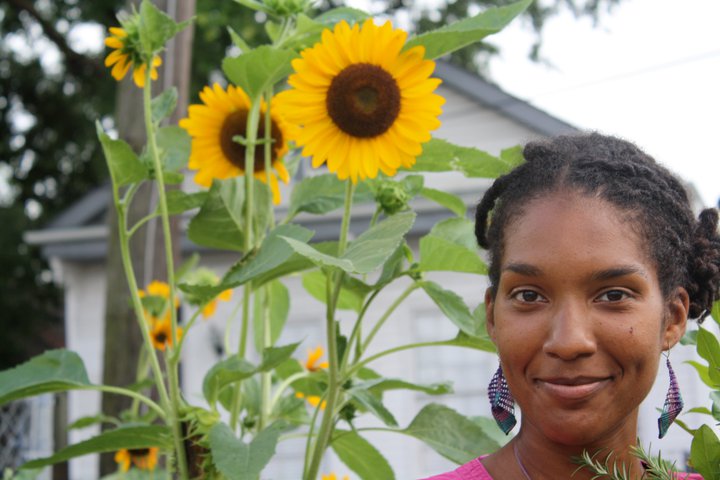The Lower 9th Ward was arguably the epicenter of the massive flooding that followed the failure of the levees after Hurricane Katrina on Aug 29, 2005. While the neighborhood will forever be marked by that epic event, it’s not all that identifies this historic and intrinsic part of New Orleans. This week, in the first of a new “Voices” feature, NolaVie speaks with some of the residents of the Lower Nine, about their lives there, the people there, the community there. Today we talk to Jenga Mwendo, a Lower Nine native who left in her teens and returned, years later, to her roots — literally.

Jenga Mwenda returned to her native New Orleans post-Katrina, and has been nurturing new growth in the Lower 9th Ward. (Photo: Hanna Rasanen)
To hear Sharon Litwin interview Jenga Mwendo on WWNO, click here.
It’s pretty shocking to realize that while days often seem to pass slowly, the years, in fact, fly by. So it was a real surprise to discover that it has been almost two years since I checked in with Jenga Mwendo about how things were going in the Lower Ninth Ward. Like so many of her generation – she’s in her middle 30s now – when she was in her teenage years, she couldn’t wait to get out of New Orleans.
“I left after high school and moved to New York,” she says. “I worked in computer animation and I was in New York when Katrina hit and that’s when I decided I needed to come back.”
So she did, not really knowing what she would do when she got here. As a child, she’d spent her earliest years growing up in Lower Nine. Returning there, she decided the most helpful thing she could do would be first to identify and then to build on assets already existing.
Talking with some of the older residents, Jenga realized that growing food was something they had always done — with neighbors using and sharing their bounty. Working with some longtime Lower Nine residents, two community gardens were started where young and old now come to plant and grow food while re-creating a pre-Katrina sense of community. Out of that community effort grew the Backyard Gardeners Network.
“There’s a very strong cultural tradition of growing food in this community,” Jenga explains. “It was something that was already there. I just didn’t know it as a kid growing up.”
The past two years have been busy and successful ones for the Backyard Gardeners Network. But there’s still so much more that needs to happen in a part of our city that still has way too many overgrown lots and not one grocery store.
Jenga says she would like to see the Lower Ninth Ward grow into a strong community, “as it has historically been, where African Americans can live and prosper and grow together.”
But gentrification is inevitably creeping into Lower Nine. So how will that affect Jenga’s wish for prosperity and growth?
“The problem with gentrification isn’t in co-existing,” Jenga says. “I think living in a diverse community is wonderful. It’s a wonderful experience, a wonderful way to raise our children around different people. The problem comes when a group of people who have historically been oppressed end up being forced out of the neighborhood. It would be fundamentally unfair for that to end up happening.”
Tomorrow on Voices of the Lower Ninth Ward: The House of Dance and Feathers. Future Voices series will look at other New Orleans neighborhoods. Email comments and suggestions about this and other areas and people to cover to editor@ nolavie.com.
 NOLAbeings Multimedia artist Claire Bangser created NOLAbeings as a portrait-based story project that marries...
NOLAbeings Multimedia artist Claire Bangser created NOLAbeings as a portrait-based story project that marries...  Voodoo in New Orleans: Reviving history: New Orleans fortune telling This article takes a deep dive into the history of Voodoo in New Orleans, its hybridization with Catholicism, and its present-day place in the city's culture. The author visits fortune-tellers in the French Quarter, using their guidance as a tool for introspection rather than a deterministic predictor of the future. Through her experiences in New Orleans, the author feels a mystical connection to both the past and the future.
Voodoo in New Orleans: Reviving history: New Orleans fortune telling This article takes a deep dive into the history of Voodoo in New Orleans, its hybridization with Catholicism, and its present-day place in the city's culture. The author visits fortune-tellers in the French Quarter, using their guidance as a tool for introspection rather than a deterministic predictor of the future. Through her experiences in New Orleans, the author feels a mystical connection to both the past and the future. 